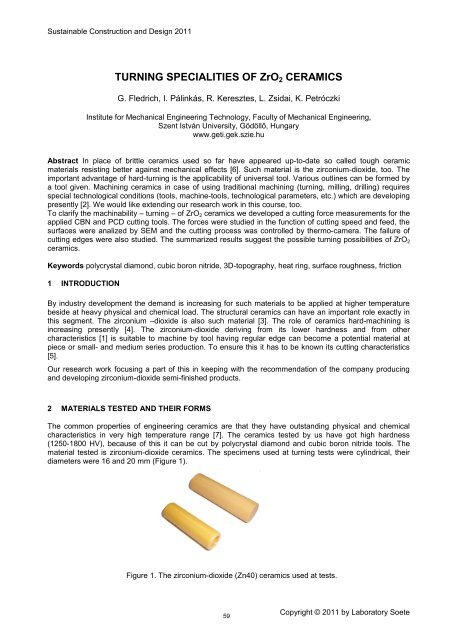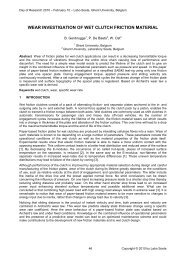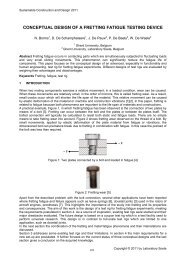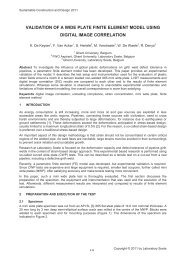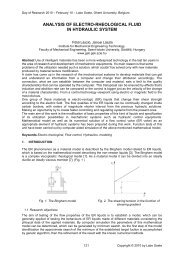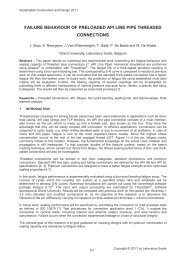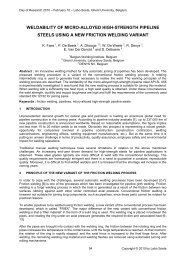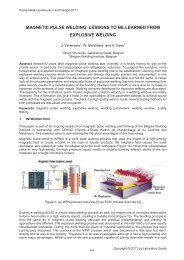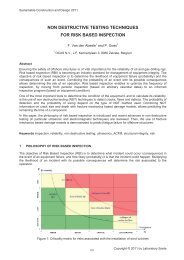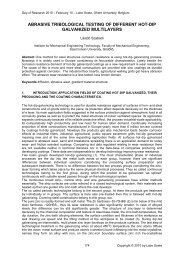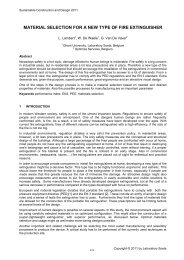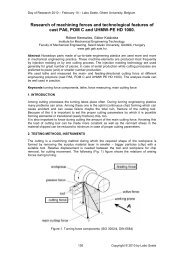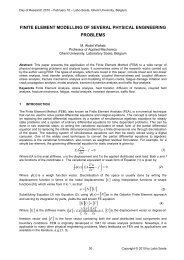Sustainable C<strong>on</strong>structi<strong>on</strong> and Design <str<strong>on</strong>g>2011</str<strong>on</strong>g> [2] Larsen, T., Andersen, T.L., Thorning, B., Horsewell, A., Vigild, M.E., Comparis<strong>on</strong> of fricti<strong>on</strong> and wear for an epoxy resin reinforced by a glass or a carb<strong>on</strong>/aramid hybrid weave, Wear, 262, 1013-1020, 2007. [3] Sumer, M., Unal, H., Mimaroglu, A., Evaluati<strong>on</strong> of tribological behaviour of PEEK and glass fibre reinforced PEEK composite under dry sliding and water lubricated c<strong>on</strong>diti<strong>on</strong>s, Wear, 265, 1061-1065, 2008. [4] Chang, L., Zhang, Z., Tribological properties of epoxy nanocomposites. Part II. A combinative effect of short carb<strong>on</strong> fibre with nano-TiO 2 , Wear, 260, 869-878, 2006. [5] Suresha, B., Siddaramaiah, Kishore, Seetharamu, S., Kumaran, P.S., Investigati<strong>on</strong>s <strong>on</strong> the influence of graphite filler <strong>on</strong> dry sliding wear and abrasive wear behaviour of carb<strong>on</strong> fabric reinforced epoxy composites, Wear, 267, 1405-1414, 2009. [6] Jia, J.H., Zhou, H.D., Gao, S.Q., Chen, J.M., A comparative investigati<strong>on</strong> of the fricti<strong>on</strong> and wear behavior of polymide composites under dry sliding and water-lubricated c<strong>on</strong>diti<strong>on</strong>, Materials Science and Engineering A, 356, 48-53, 2003. [7] Jia, J., Chen, J., Zhou, H., Hu, L., Chen, L., Comparative investigati<strong>on</strong> <strong>on</strong> the wear and transfer behaviors of carb<strong>on</strong> fiber reinforced polymer composites under dry sliding and water lubricati<strong>on</strong>, Composites Science and Technology, 65, 1139-1147, 2005. [8] Zhang, H., Zhang, Z., Friedrich, K., Effect of fiber length <strong>on</strong> the wear resistance of short carb<strong>on</strong> fiber reinforced epoxy composites, Composite Science and Technology, 67, 222-230, 2007. [9] Zhou, X.H., Sun, Y.S., Wang, W.S., Influences of carb<strong>on</strong> fabric/epoxy composites fabricati<strong>on</strong> process <strong>on</strong> its fricti<strong>on</strong> and wear properties, Journal of Materials Processing Technology, 209, 4553-4557, 2009. [10] Lu, X., W<strong>on</strong>g, K.C., W<strong>on</strong>g, P.C., Mitchell, K.A.R., Cotter, J., Eadie, D.T., Surface characterizati<strong>on</strong> of polytetrafluoroethylene (PTFE) transfer films during rolling-sliding tribology tests using X-ray photoelectr<strong>on</strong> spectroscopy, Wear, 261, 1155-1162, 2006. [11] Suresha, B., Chandramohan, G., Siddaramaiah, Samapthkumaran, P., Seetharamu, S., Three-body abrasive wear behaviour of carb<strong>on</strong> and glass fiber reinforced epoxy composites, Materials Science and Engineering A, 443, 285-291, 2007. [12] Yamamoto, Y., Hashimoto, M., Fricti<strong>on</strong> and wear of water lubricated PEEK and PPS sliding c<strong>on</strong>tacts Part 2. Composites with carb<strong>on</strong> or glass fibre, Wear, 257, 181-189, 2004. [13] Kukureka, S.N., Hooke, C.J., Rao, M., Liao, P., Chen. Y.K., The effect of fibre reinforcement <strong>on</strong> the fricti<strong>on</strong> and wear of polyamide 66 under dry rolling-sliding c<strong>on</strong>tact, Tribology <str<strong>on</strong>g>Internati<strong>on</strong>al</str<strong>on</strong>g>, 32, 107- 116, 1999. [14] Werner, P., Altstadt, V., Jaskulka, R., Jacobs, O., Sandler, J.K.W., Shaffer, M.S.P., Windle, A.H., Tribological behaviour of carb<strong>on</strong>-nanofibre-reinforced poly(ether ether ket<strong>on</strong>e), Wear, 257, 1006- 1014, 2004. [15] Friedrich, K., Zhang, Z., Schlarb, A.K., Effects of various fillers <strong>on</strong> the sliding wear of polymer composites, Composites Sliding and Technology, 65, 2329-2343, 2005. [16] Zhang, G., Rasheva, Z., Schlarb, A.K., Fricti<strong>on</strong> and wear variati<strong>on</strong>s of short carb<strong>on</strong> fiber (SCF)/PTFE/graphite (10 vol.%) filled PEEK: Effects of fiber orientati<strong>on</strong> and nominal c<strong>on</strong>tact pressure, Wear, 268, 893-899, 2010. [17] Myshkin, N.K., Petrokovets, M.I., Kovalev, A.V., Tribology of polymers: Adhesi<strong>on</strong>, fricti<strong>on</strong>, wear and mass-transfer, Tribology <str<strong>on</strong>g>Internati<strong>on</strong>al</str<strong>on</strong>g>, 38, 910-921, 2005. [18] Mohrbacher, H., Celis, J.P., Roos, J.R., Laboratory testing of displacement and load induced fretting, Tribology <str<strong>on</strong>g>Internati<strong>on</strong>al</str<strong>on</strong>g>, 28(5), 269-278, 1995. [19] Buijnsters, J.G., Camero, M., Vázquez, L., Agulló-Rueda, F., Gago, R., Jiménez, I., Gómez- Aleixandre, C., Albella, J.M., Diam<strong>on</strong>d and Related Materials, 19, 1093-1102, 2010. 58 Copyright © <str<strong>on</strong>g>2011</str<strong>on</strong>g> by Laboratory Soete
Sustainable C<strong>on</strong>structi<strong>on</strong> and Design <str<strong>on</strong>g>2011</str<strong>on</strong>g> TURNING SPECIALITIES OF ZrO 2 CERAMICS G. Fledrich, I. Pálinkás, R. Keresztes, L. Zsidai, K. Petróczki Institute for Mechanical Engineering Technology, Faculty of Mechanical Engineering, Szent István University, Gödöllő, Hungary www.geti.gek.szie.hu Abstract In place of brittle ceramics used so far have appeared up-to-date so called tough ceramic materials resisting better against mechanical effects [6]. Such material is the zirc<strong>on</strong>ium-dioxide, too. The important advantage of hard-turning is the applicability of universal tool. Various outlines can be formed by a tool given. Machining ceramics in case of using traditi<strong>on</strong>al machining (turning, milling, drilling) requires special technological c<strong>on</strong>diti<strong>on</strong>s (tools, machine-tools, technological parameters, etc.) which are developing presently [2]. We would like extending our research work in this course, too. To clarify the machinability – turning – of ZrO 2 ceramics we developed a cutting force measurements for the applied CBN and PCD cutting tools. The forces were studied in the functi<strong>on</strong> of cutting speed and feed, the surfaces were analized by SEM and the cutting process was c<strong>on</strong>trolled by thermo-camera. The failure of cutting edges were also studied. The summarized results suggest the possible turning possibilities of ZrO 2 ceramics. Keywords polycrystal diam<strong>on</strong>d, cubic bor<strong>on</strong> nitride, 3D-topography, heat ring, surface roughness, fricti<strong>on</strong> 1 INTRODUCTION By industry development the demand is increasing for such materials to be applied at higher temperature beside at heavy physical and chemical load. The structural ceramics can have an important role exactly in this segment. The zirc<strong>on</strong>ium –dioxide is also such material [3]. The role of ceramics hard-machining is increasing presently [4]. The zirc<strong>on</strong>ium-dioxide deriving from its lower hardness and from other characteristics [1] is suitable to machine by tool having regular edge can become a potential material at piece or small- and medium series producti<strong>on</strong>. To ensure this it has to be known its cutting characteristics [5]. Our research work focusing a part of this in keeping with the recommendati<strong>on</strong> of the company producing and developing zirc<strong>on</strong>ium-dioxide semi-finished products. 2 MATERIALS TESTED AND THEIR FORMS The comm<strong>on</strong> properties of engineering ceramics are that they have outstanding physical and chemical characteristics in very high temperature range [7]. The ceramics tested by us have got high hardness (1250-1800 HV), because of this it can be cut by polycrystal diam<strong>on</strong>d and cubic bor<strong>on</strong> nitride tools. The material tested is zirc<strong>on</strong>ium-dioxide ceramics. The specimens used at turning tests were cylindrical, their diameters were 16 and 20 mm (Figure 1). Figure 1. The zirc<strong>on</strong>ium-dioxide (Zn40) ceramics used at tests. 59 Copyright © <str<strong>on</strong>g>2011</str<strong>on</strong>g> by Laboratory Soete


